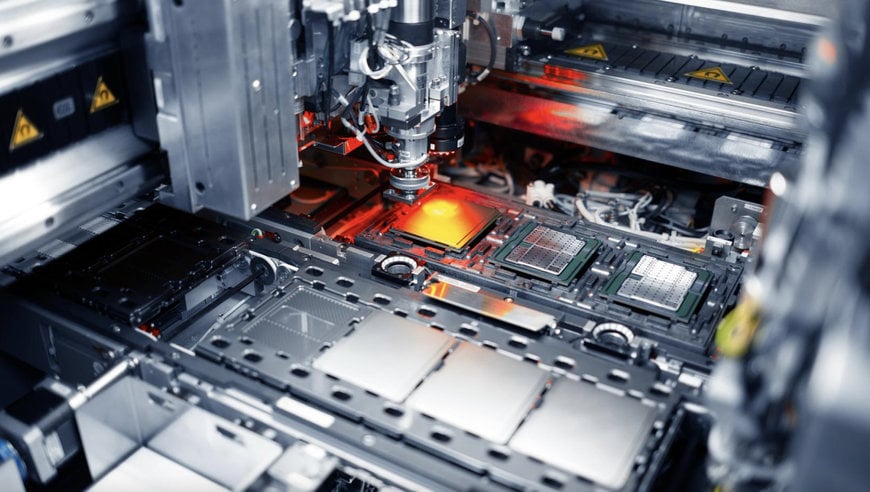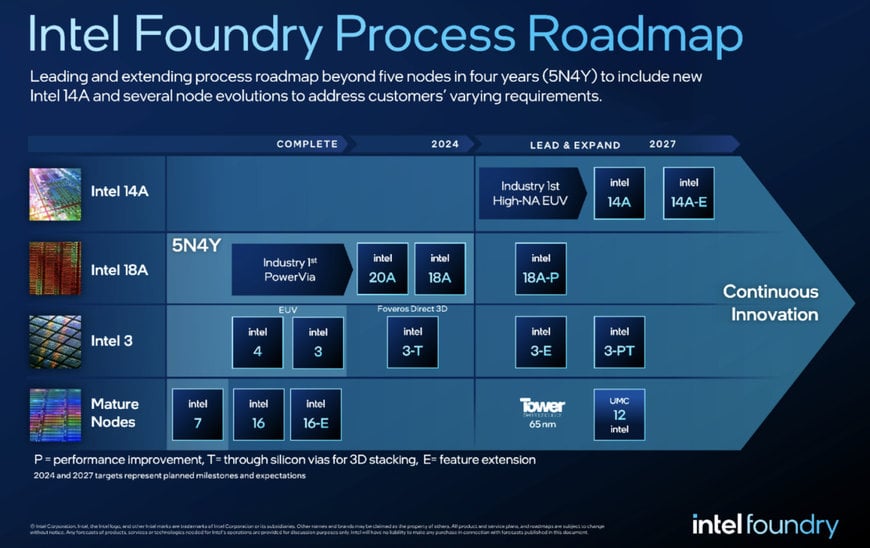electronics-journal.com
23
'24
Written on Modified on
INTEL LAUNCHES WORLD’S FIRST SYSTEMS FOUNDRY DESIGNED FOR THE AI ERA
Intel announces expanded process roadmap, customers and ecosystem partners to deliver on its ambition to be the No. 2 foundry by 2030.

An intel manufacturing employee displays a test system-on-chip built on a glass substrate at an Intel fab in Chandler, Arizona, in December 2023. In February 2024, Intel Corporation launched Intel Foundry as the world's first systems foundry for the Al era, delivering leadership in technology, resiliency and sustainability. (Credit: Intel Corporation)
Intel launched Intel Foundry as a more sustainable systems foundry business designed for the AI era and announced an expanded process roadmap designed to establish leadership into the latter part of this decade. The company also highlighted customer momentum and support from ecosystem partners – including Synopsys, Cadence, Siemens and Ansys – who outlined their readiness to accelerate Intel Foundry customers’ chip designs with tools, design flows and IP portfolios validated for Intel’s advanced packaging and Intel 18A process technologies.
“AI is profoundly transforming the world and how we think about technology and the silicon that powers it,” said Intel CEO Pat Gelsinger. “This is creating an unprecedented opportunity for the world’s most innovative chip designers and for Intel Foundry, the world’s first systems foundry for the AI era. Together, we can create new markets and revolutionize how the world uses technology to improve people’s lives.”

A photo shows a factory tool that places lids on data centre system-on-chips at an Intel fab in Chandler, Arizona, in December 2023, In February 2024. Intel Corporation launched Intel Foundry as the world's first systems foundry for the Al era, delivering leadership in technology, resiliency and sustainability. (Credit: Intel Corporation)
Process Roadmap Expands Beyond 5N4Y
Intel’s extended process technology roadmap adds Intel 14A to the company’s leading-edge node plan, in addition to several specialized node evolutions. Intel also affirmed that its ambitious five-nodes-in-four-years (5N4Y) process roadmap remains on track and will deliver the industry’s first backside power solution. Company leaders expect Intel will regain process leadership with Intel 18A in 2025.
The new roadmap includes evolutions for Intel 3, Intel 18A and Intel 14A process technologies. It includes Intel 3-T, which is optimized with through-silicon vias for 3D advanced packaging designs and will soon reach manufacturing readiness. Also highlighted are mature process nodes, including new 12 nanometer nodes expected through the joint development with UMC announced last month. These evolutions are designed to enable customers to develop and deliver products tailored to their specific needs. Intel Foundry plans a new node every two years and node evolutions along the way, giving customers a path to continuously evolve their offerings on Intel’s leading process technology.

Intel also announced the addition of Intel Foundry FCBGA 2D+ to its comprehensive suite of ASAT offerings, which already include FCBGA 2D, EMIB, Foveros and Foveros Direct.
Intel launched Intel Foundry as a more sustainable systems foundry business designed for the AI era and announced an expanded process roadmap designed to establish leadership into the latter part of this decade. The company also highlighted customer momentum and support from ecosystem partners – including Synopsys, Cadence, Siemens and Ansys – who outlined their readiness to accelerate Intel Foundry customers’ chip designs with tools, design flows and IP portfolios validated for Intel’s advanced packaging and Intel 18A process technologies.
“AI is profoundly transforming the world and how we think about technology and the silicon that powers it,” said Intel CEO Pat Gelsinger. “This is creating an unprecedented opportunity for the world’s most innovative chip designers and for Intel Foundry, the world’s first systems foundry for the AI era. Together, we can create new markets and revolutionize how the world uses technology to improve people’s lives.”

A photo shows a factory tool that places lids on data centre system-on-chips at an Intel fab in Chandler, Arizona, in December 2023, In February 2024. Intel Corporation launched Intel Foundry as the world's first systems foundry for the Al era, delivering leadership in technology, resiliency and sustainability. (Credit: Intel Corporation)
Process Roadmap Expands Beyond 5N4Y
Intel’s extended process technology roadmap adds Intel 14A to the company’s leading-edge node plan, in addition to several specialized node evolutions. Intel also affirmed that its ambitious five-nodes-in-four-years (5N4Y) process roadmap remains on track and will deliver the industry’s first backside power solution. Company leaders expect Intel will regain process leadership with Intel 18A in 2025.
The new roadmap includes evolutions for Intel 3, Intel 18A and Intel 14A process technologies. It includes Intel 3-T, which is optimized with through-silicon vias for 3D advanced packaging designs and will soon reach manufacturing readiness. Also highlighted are mature process nodes, including new 12 nanometer nodes expected through the joint development with UMC announced last month. These evolutions are designed to enable customers to develop and deliver products tailored to their specific needs. Intel Foundry plans a new node every two years and node evolutions along the way, giving customers a path to continuously evolve their offerings on Intel’s leading process technology.

Intel also announced the addition of Intel Foundry FCBGA 2D+ to its comprehensive suite of ASAT offerings, which already include FCBGA 2D, EMIB, Foveros and Foveros Direct.
www.intel.com

